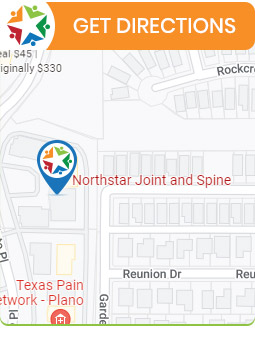Complex Regional Pain Syndrome (CRPS) Specialist in Plano, TX
Complex Regional Pain Syndrome (CRPS) is a chronic pain condition that usually affects an arm or leg, causing intense pain, swelling, and changes in the skin’s color and temperature. The symptoms can be debilitating and may worsen over time if not properly treated. Treatment often includes physical therapy, medications, and pain management strategies. At Northstar Joint and Spine, Dr. Robert J. Nocerini, a board-certified specialist, offers personalized care to manage CRPS symptoms and improve your quality of life. For more information, contact us today or schedule an appointment. We are conveniently located at 7704 San Jacinto Pl Suite #200 Plano, TX 75024.


Table of Contents:
What is Complex Regional Pain Syndrome (CRPS)?
What causes Complex Regional Pain Syndrome?
What are the symptoms of CRPS?
How is CRPS diagnosed?
Are You Suffering from Complex Regional Pain Syndrome (CRPS)? Consult Dr. Robert J. Nocerini, MD in Plano, TX
Complex Regional Pain Syndrome (CRPS) is a chronic condition that typically affects a limb and is known for producing a level of pain that seems out of proportion to what would normally be expected. It often begins after a minor event that doesn’t justify the level of intensity or persistence of the symptoms that follow. The nervous system seems to respond abnormally during CRPS, leading to exaggerated pain signals and changes in temperature, color, or swelling in the affected area. In some cases, even light touch or movement can become difficult to tolerate.
What makes CRPS particularly challenging is that its presentation can vary among different cases. Some individuals experience burning pain that spreads beyond the original site, while others notice stiffness, changes in skin texture, or even changes in hair and nail growth. These symptoms can shift over time, sometimes improving on their own, but often becoming more severe without proper care. The condition can have both physical and neurological consequences, requiring a specialized treatment approach that addresses both pain levels and nervous system sensitivity.
The exact cause of CRPS can be difficult to discern, but in many cases, it can involve a disruption in how the body’s nerves communicate with the brain and spinal cord. When the nervous system becomes dysregulated, even mild physical events can impact circulation, sensation, and how the brain processes pain. This abnormal nerve response can lead to a cycle where pain and inflammation reinforce each other, even in the absence of ongoing physical damage. As a result, the limb may become hypersensitive and react in ways that don’t align with the original source of discomfort. In some cases, both the peripheral and central nervous systems are involved, meaning the issue doesn’t stay local but spreads to involve broader networks in the body. Circulatory changes, abnormal immune responses, and heightened nerve activity all have the potential to influence the condition. The specialists at Northstar Joint and Spine consider these factors when evaluating and managing CRPS, aiming to intervene before symptoms become harder to control over time.
CRPS can be unpredictable in many ways, both in how it begins and how it progresses. The pain is often described as burning or tingling and can spread beyond the initial area. In some cases, the affected limb may feel colder or warmer than the rest of the body, or may appear swollen, red, or pale. Skin sensitivity tends to increase, with some individuals finding that even light fabrics or a gentle breeze can trigger discomfort. These symptoms may also fluctuate, worsening with certain movements or environmental changes. CRPS can affect motor function as well. The individual might notice reduced range of motion, muscle weakness, or a feeling of stiffness that makes it harder to use the limb as usual. Over time, changes in skin thickness, hair growth, and nail appearance can develop. Localized pain has the potential to evolve into a broader neurological issue if not addressed early. Because of the wide range of symptoms and the way they mimic other conditions, getting a clear diagnosis often requires a close and thorough evaluation by providers familiar with the condition.
Diagnosing CRPS involves looking at both the physical symptoms and the broader patterns that set it apart from other pain conditions. There isn’t a single test that confirms it, so the process often begins with an examination. Providers may look for signs such as abnormal skin color, temperature changes, or swelling, among others. In many cases, the diagnosis involves observing how the symptoms behave over time, especially when they affect the limb in a way that doesn’t follow a typical joint condition. Imaging studies and other diagnostic tools may be used to rule out alternative causes as well. What often helps is recognizing the combination of symptoms, particularly in situations where there is a lack of another clear explanation for them. When providers suspect CRPS, early identification can help guide more effective treatment aimed at reducing nerve sensitivity and preventing long-term dysfunction. The specialist at Northstar Joint and Spine will evaluate the physical findings to accurately diagnose the condition.
Complex Regional Pain Syndrome (CRPS) is a chronic pain condition that can cause severe discomfort in the affected limb. Dr. Robert J. Nocerini, a board-certified specialist, at Northstar Joint and Spine in Plano, TX, specializes in diagnosing and treating CRPS. With his extensive experience in pain management, Dr. Nocerini uses advanced diagnostic techniques to assess the severity of CRPS and determine the most effective course of treatment. His goal is to reduce pain and improve function for those suffering from this debilitating condition.
Dr. Nocerini’s personalized approach ensures that each patient receives the best possible care for managing CRPS, helping them regain control of their lives and improve their overall quality of life in Plano, TX.
Complex Regional Pain Syndrome (CRPS) treatment is available at Northstar Joint and Spine. For more information, contact us today or schedule an appointment. We are conveniently located at 7704 San Jacinto Pl Suite #200 Plano, TX 75024. We serve patients from Plano TX, Willow Bend TX, Frisco TX, Allen TX, Addison TX, North Dallas TX, and surrounding areas.

Check Out Our 5 Star Reviews


Additional Services You May Need
▸ Back Pain
▸ Chronic Pain
▸ Epidural Steroid Injections
▸ Spinal Cord Stimulation
▸ Viscosupplementation
▸ Genicular Nerve Blocks
▸ Facet Injections
▸ Joint Injections
▸ Sacroiliac Joint Injections
▸ Lumbar and Cervical
▸ Facet Medial Branch Blocks
▸ Diagnostic Nerve Blocks
▸ Medication Management
▸ Neck Pain Doctor
▸ Diabetic Peripheral Neuropathy
▸ Headaches
▸ Suboxone
▸ Botox for Migraines
▸ Peripheral Nerve Stimulation
▸ Spine
▸ Joints
▸ Muscles
▸ Bones

Additional Services You May Need
▸ Back Pain
▸ Chronic Pain
▸ Epidural Steroid Injections
▸ Spinal Cord Stimulation
▸ Viscosupplementation
▸ Genicular Nerve Blocks
▸ Facet Injections
▸ Joint Injections
▸ Sacroiliac Joint Injections
▸ Lumbar and Cervical
▸ Facet Medial Branch Blocks
▸ Diagnostic Nerve Blocks
▸ Medication Management
▸ Neck Pain Doctor
▸ Diabetic Peripheral Neuropathy
▸ Headaches
▸ Suboxone
▸ Botox for Migraines
▸ Peripheral Nerve Stimulation
▸ Spine
▸ Joints
▸ Muscles
▸ Bones






